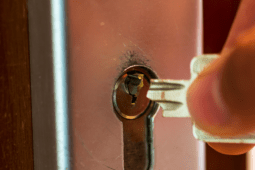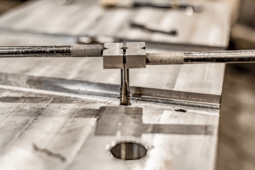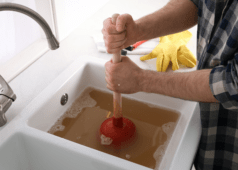How To: Build a Memory Palace to Memorize Virtually Anything

If you've watched the recent four-season BBC Sherlock series, you may recall that the titular character expertly played by Benedict Cumberbatch goes spelunking deep into his “mind palace” for details to solve his cases. The idea of an eidetic memory (the ability to recall information after mere moments of passive exposure to it) is debated, but if you watch carefully, it seems that Holmes constantly, actively stores information in imaginary places in his mind.
This is a tool grounded in reality, it's older than dirt, and you can use it to memorize virtually any set of information, from bank account numbers, to anatomical terms for med school, to Brazilian jiu-jitsu moves.
Let's go diving!
The method of loci and other mnemonics
First, a really brief bit of history: the main tool in your memory palace, the method of loci (from the Latin for “place”), is a memory tool that uses your imagination to give your mind something tangible on which to hang information. It's an ancient tool, like, Ancient Greece kind of ancient. Rhetoricians like Cicero used the method of loci to help memorize long speeches for debate.
The essence of tool goes something like this:
Choose a place you're familiar with. For this example, I'll choose my single-story ranch home. Next, create an imaginary route through your place: mine starts in the master bedroom, walking down the hallway, briefly peeking in rooms until I reach the living room and kitchen, and finally ending in the family room and laundry room. Finally, place points of your speech throughout the route, from start to finish. (It's how we get the expressions “In the first place,” “In the second place,” etc.)
The memory palace method I'll describe in this post uses the method of loci as its main framework, then uses other mnemonic tools (from the Greek for “mindful”) to plug pieces of information into the palace, in the form of strong visual images. We'll get into these other devices in a moment.

Why do mnemonics work so well?
Your brain is designed to remember things that are personal, strange, and sensory-based. It has a lot harder time remembering intangible, abstract information. Getting into the neuroscience that backs this up is outside the scope of this article, but experience clearly shows that this rings true. Do you have a horrible time remembering phone numbers? (Especially since you don't manually dial them anymore?) And yet, do you remember really random events from your childhood? Exactly. Your brain doesn't care about pure numbers because it doesn't have an emotional connection to them.
The trick to remembering intangible information is encoding it in a way that produces an emotional reaction of some kind.

How to set up a memory palace to remember virtually anything
The basic principle: for each piece of information you want to remember long-term, write a really short story. The weirder and more random the story, the better you'll remember it.
Below is a step-by-step tutorial for creating stories based on the example of my memory palace for memorizing numbers.
By the way, you'll note as you read on that setting up a memory palace can be a time-consuming process! But the way I see it, setting up a crazy memory palace is a lot more fun than reviewing information over and over and over again, ad nauseum. Why bang your head against the wall when you can just draw a door and knock three times? (Bonus points for knowing the 80's movie reference.)
I. Pick a location you're familiar with.
My memory palace for memorizing numbers is my parents' old condo on the campus of Pepperdine University in California.
Note: the classic example is your house, but really, your location can exist anywhere in time and space. It can even be fictional! You just have to see it clearly enough in your mind's eye. And it can scale, tiny to huge. So you can make a memory palace out of virtually anything—your refrigerator, a sailboat, your grandparents' house, your old hometown, the Millennium Falcon, the entire country of Austria, whatever.
II. Divide up the location into zones.
Divide your memory palace into zones, arrange the elements of the information you want to remember into categories, then give each category a zone. For example, you would do well to arrange a memory palace for language vocabulary into zones for parts of speech: one zone for verbs, one for adjectives, one for pronouns, etc.
For my numbers palace, I created 10 zones, one for each digit 0–9.
0 — garage
1 — downstairs bathroom
2 — first guest room downstairs
3 — second guest room downstairs
4 — living room
5 — dining room
6 — kitchen
7 — half bathroom
8 — master bedroom
9 — master bathroom
III. Assign a tour guide to each zone.
I like to give my memory palaces tour guides because they make the stories more vivid, more weird, and therefore more memorable. And frankly, since I usually use pop culture characters, it makes my palaces more fun to set up and use.
0 — garage: Luke Skywalker
1 — downstairs bathroom: Tintin (Belgian comic series)
2 — first guest room downstairs: Nightcrawler (from Marvel's X-Men)
3 — second guest room downstairs: Inigo Montoya (from The Princess Bride)
4 — living room: Robin Hood (Disney animated version)
5 — dining room: Gilderoy Lockhart (from film version of Harry Potter and the Chamber of Secrets)
6 — kitchen: Indiana Jones
7 — half bathroom: Bowser (Mario 64 version)
8 — master bedroom: Felix the Cat
9 — master bathroom: Doc Brown (from Back to the Future)
Is it getting weird yet? Good. That means we're on the right track.
IV. Objects + interactions = story.
To show you how to write a story for your memory palace, let's plug in a random number to my numbers palace.
I'll be using 012251, the seven-digit SKU number at Lowe's for the strip of globe lights I used to replace the hideous fixture above the sink in my hall bathroom.
Note: I'm using an additional technique called the “major system” to convert numbers to images. It's outside of the scope of this article to explain this technique, but Wikipedia actually has a clear, comprehensive guide here.
Breaking down 012251 into pairs, you get 01 – 22 – 25 – 1, which I'll encode into the following images using the major system:
01 — zit
22 — nun
25 — nail
1 — Tintin
(When I get a number with odd digits, I encode the last single digit with a memory palace guide.)
Next, I'll write a story hosted by the palace guide that starts with the first number, 0 for Luke Skywalker:
(Note: If I were doing this story over, I would probably alter the story slightly to signify what the story was about—for example, at the beginning, I would say that he pulled a light fixture over to his landspeeder to check his reflection, which is how he sees the zit. I still remembered the story without it, though, so it's just an extra reinforcement.)
I originally came up with this story to test the major system. It's a really stupid story, it took less than five minutes to encode into images, but I did it over a year ago and still remember it distinctly despite having barely reviewed it. (The last time I even thought about it was over 6 months ago.) All I had to do after recalling my stupid story was to decode the numbers from the images.
This brings up one final point: after a while without regular review, the only thing you're going to quickly recall is your stupid story. It will probably take some work to decode your information. That's totally OK! The point is that memory palaces help you effectively store information in your long-term memory to access without looking it up; it's regular use that makes the information itself instantly accessible in your mind, just like with your phone number.

A few more notes:
- When you set up your memory palace, you don't have to use a path if the information isn't meant to be sequential. So if you're trying to memorize random numbers, you don't need a path, but if you're memorizing the main points of a speech, place them in a path in your palace.
- If you really want to beef up your palaces, you can add other mnemonic devices: rhyming, songs, acronyms. Also, using images that sound like what you're trying to remember is very effective.
- One of the best uses for a memory palace is for learning languages! I have several palaces that I set up a couple of years ago: for German (the town of Searcy, AR), Ancient Greek (the town of Shepherdstown, WV), Ancient Hebrew (Scotland—yes, the whole country). It's a good practice to choose a new palace for each set of information you're trying to set up.
- And finally: you don't always have to set up a memory palace! Sometimes simple mnemonics are suitable. For example: I make random mnemonics for names without committing them to a palace and recall them whenever I see that person again. For example, Keith at church wears a bolo tie; Keith rhymes with teeth, so I picture him wearing a bolo made out of a small set of dentures. When I see my neighbors Donald and Wanda drive by, I picture a wizard doing a magic spell with a tiny Ronald McDonald as a wand. Again, it's really stupid, but effortless!
Suggested reading:
Master of Memory — This is my favorite guide on memory palaces. The podcast in particular is a fantastic resource. It hasn't been updated in nearly two years and isn't organized by topic, but its 600-odd short episodes give really good examples for how to encode any kind of information into memory palaces.









